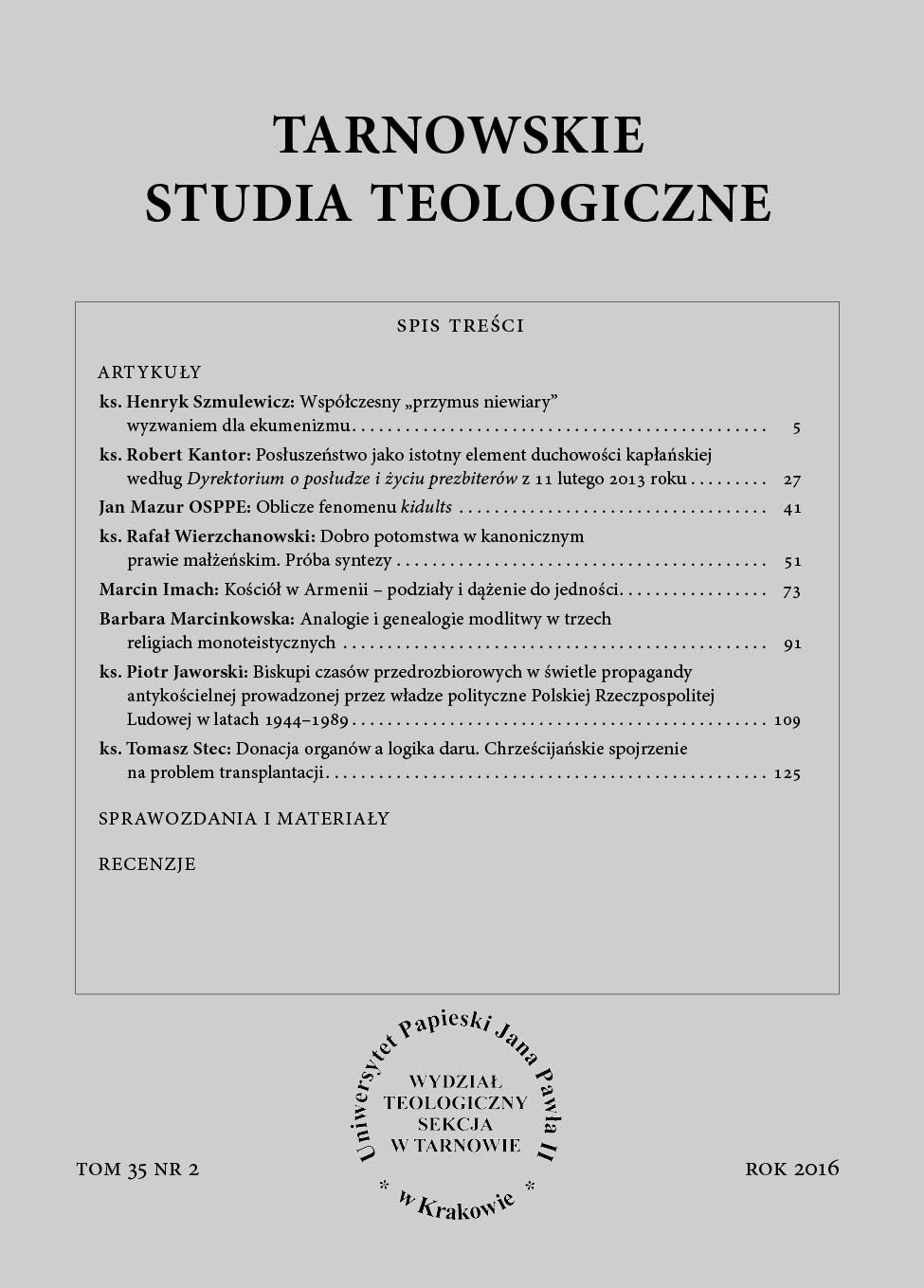Church in Armenia – divisions and striving for unity
DOI:
https://doi.org/10.15633/tst.2106Keywords:
Ormian, ecumenism, Middle EastAbstract
The hundredth anniversary of extermination of the Armenians celebrated in the year 2015 contributed to a greater interest not only to Armenia and Armenians but also to the history of the Armenian Church. This article outlines briefly geographical and historical background of Armenia in order to show complex image of the country which as the first in the history adopted the Christian faith as an official religion. Through the centuries we note many divisions inside this church because of theological differences as well as geographical reasons. As a result the Armenian Apostolic Church did not accept the supremacy of the pope. Although the dialogue with the Armenians continued from the twelfth century, it was not until the seventeenth century when a group of Armenians recognizing the primacy of the Pope established the Catholic Church of the Armenian rite. The twentieth century brought initiatives from the part of Rome as well as from the Armenians to unite the Armenian Apostolic Church and to bring all Armenians to the unity with Rome and the Pope. The element that aid the unity is the common remembrance of the Armenian genocide committed by the Turks in 1915–1916.References
Bukowski K., Religie świata wobec chrześcijaństwa, Kraków 1999.
Curanowić A., Religie, Kościoły i konflikty międzywyznaniowe w regionie Kaukazu, w: Wprowadzenie do studiów wschodnioeuropejskich, red. M. Korzeniowski, D. Tarasiuk, K. Latawiec, Lublin 2013, s. 189–226.
Gstrein H., Skazany na chłostę i śmierć, przeł. J. Borowiczowa, Warszawa 1991.
http://ekumenizm.wiara.pl/doc/477865.Ormianski-Kosciol-Apostolski-Kosciol-OrmianskoGregorianski (13.05.2015).
http://www.magazyn.ekumenizm.pl/content/article/20040705134933238.htm (18.05.2015)
http://www.ordynariat.ormianie.pl/(13.05.2015).Jan Paweł II, Encyklika Ut unum sint.
Karski K., Kronika wydarzeń ekumenicznych styczeń–czerwiec 2008, w: Studia i dokumenty ekumeniczne, red. K. Karski, Warszawa 2008, s. 162–164.
Kongregacja Nauki Wiary, Deklaracja Dominus Iesus.
Kucharczyk G., Pierwszy holokaust XX wieku, Warszawa 20014.
Kumor B., Historia Kościoła, cz. 8: Czasy współczesne 1914–1992, Lublin 1996.
Machut-Mendecka E., Archetypy islamu, Warszawa 2005.
Nitkiewicz K., Katolickie Kościoły wschodnie, Sandomierz 2014.
Rudnicka-Kassem D., John Paul II, Islam and the Middle East, Kraków 2012.
Roberson R., Chrześcijańskie Kościoły wschodnie, przeł. K. Bielawski, D. Mionskowska, Bydgoszcz 1998.
Simon M., Cywilizacja wczesnego chrześcijaństwa, przeł. E. Bakowska, Warszawa 1979.
Siniscalco P., Starożytne Kościoły wschodnie, przeł. K. Piekarz, Kraków 2013.
Sobór Watykański II, Dekret o ekumenizmie Unitatis redintegratio.
Sobór Watykański II, Dekret o Kościołach wschodnich katolickich Orientalium Ecclesiarum.
Stopka K., Armenia Christiana, Kraków 2002.
Downloads
Published
Issue
Section
License
Copyright (c) 2017 Marcin Imach

This work is licensed under a Creative Commons Attribution 4.0 International License.
Twórca oświadcza, że służą mu prawa autorskie do utworu i że nie są ograniczone w zakresie objętym niniejszym oświadczeniem oraz że utwór jest dziełem oryginalnym i nie narusza praw autorskich innych osób.
Twórca zezwala Uniwersytetowi Papieskiemu Jana Pawła II w Krakowie na nieodpłatne, niewyłączne i nieograniczone w czasie korzystanie z utworu, to jest:
- utrwalanie i zwielokrotnianie: wytwarzanie egzemplarzy utworu techniką drukarską, reprograficzną, zapisu magnetycznego oraz techniką cyfrową;
- obrotu oryginałem albo egzemplarzami, na których utwór utrwalono (wprowadzanie do obrotu, użyczenie lub najem oryginału albo egzemplarzy, publiczne wystawienie, wyświetlenie, a także publiczne udostępnianie utworu w taki sposób, aby każdy mógł mieć do niego dostęp w miejscu i w czasie przez siebie wybranym);
- włączenie utworu w skład utworu zbiorowego;
- udzielanie przez Uniwersytet Papieski Jana Pawła II w Krakowie sublicencji Creative Commons Uznanie autorstwa 4.0 Międzynarodowe (CC BY 4.0).
Uniwersytet Papieski Jana Pawła II w Krakowie udostępnia utwór na Platformie Czasopism należącej do uczelni, na licencji Creative Commons Uznanie autorstwa 4.0 Międzynarodowe (CC BY 4.0) Tym samym uprawnia wszystkich zainteresowanych do korzystania z utworu pod następującymi warunkami:
- zostanie podany autor i tytuł utworu,
- zostanie podane miejsce publikacji (tytuł czasopisma i adres internetowy do oryginalnie opublikowanego utworu).

